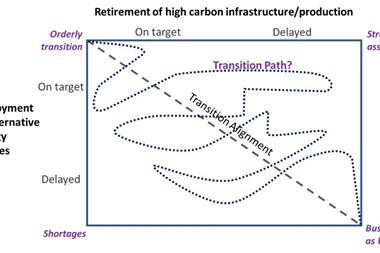The rating agency now expects world GDP to grow by 2.4% in 2022 and by just 1.7% in 2023
The European gas crisis, high inflation and a sharp acceleration in the pace of global monetary policy tightening are taking a heavy toll on economic prospects.
Fitch Ratings’ September 2022 Global Economic Outlook (GEO) includes deep and wide cuts to global GDP forecasts.
The rating agency now expects world GDP to grow by 2.4% in 2022 and by just 1.7% in 2023. The eurozone and UK are now expected to enter recession later this year and Fitch forecasts that the US will suffer a mild recession in mid-2023.
Fitch expects the eurozone economy to contract by 0.1% in 2023 - a drop of 2.2pp since June - reflecting the impact of the natural gas crisis.
The rating agency now expects US growth of 1.7% in 2022 and 0.5% in 2023.
China’s recovery is constrained by Covid-19 pandemic restrictions and a prolonged property slump, and Fitch now expects growth to be 2.8% this year and to recover to 4.5% next year.
Perfect storm
“We’ve had something of a perfect storm for the global economy in recent months, with the gas crisis in Europe, a sharp acceleration in interest rate hikes and a deepening property slump in China,” said Brian Coulton, Chief Economist.
The forecast now assumes a full or near complete shut-off of Russian pipeline gas to Europe.
Despite EU efforts to find alternatives, total EU gas supply will fall significantly in the near term, with impacts felt through industrial supply chains. These supply-side impacts would be exacerbated if rationing became necessary to avoid outright gas shortages, a key risk in Germany.
Central banks hawkish
High and persistent inflation, elevated near-term inflation expectations and tight labour markets have prompted the Fed, Bank of England (BOE) and ECB to turn more hawkish in recent months. Policy rates are increasing much more rapidly than expected.
The Fed is now expected to take rates to 4% by year-end and hold them there through 2023; the ECB refinancing rate is expected to rise to 2% by December; and the BOE Bank Rate is forecast to reach 3.25% by February 2023. The Fed and BOE are in quantitative tightening mode, with the BOE planning outright bond sales.
In contrast to the role of quantitative easing in the pandemic, central bank policies are no longer supportive of fiscal easing to protect households and firms from economic shocks.
With liquidity conditions tightening, large-scale fiscal easing could push up long-term real interest rates.
Putin exposed as Ukrainian forces recapture more territory
- 1
- 2
- 3
 Currently reading
Currently readingFitch slashes global GDP forecasts on supply shocks, faster rate rises
- 4
- 5
- 6
- 7
- 8
- 9
- 10
- 11
- 12
- 13
- 14
- 15
- 16
- 17
- 18
- 19






































No comments yet